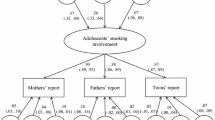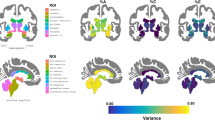Abstract
Twin and family studies implicitly assume that the covariation between family members remains constant across differences in age between the members of the family. However, age-specificity in gene expression for shared environmental factors could generate higher correlations between family members who are more similar in age. Cohort effects (cohort × genotype or cohort × common environment) could have the same effects, and both potentially reduce effect sizes estimated in genome-wide association studies where the subjects are heterogeneous in age. In this paper we describe a model in which the covariance between twins and non-twin siblings is moderated as a function of age difference. We describe the details of the model and simulate data using a variety of different parameter values to demonstrate that model fitting returns unbiased parameter estimates. Power analyses are then conducted to estimate the sample sizes required to detect the effects of moderation in a design of twins and siblings. Finally, the model is applied to data on cigarette smoking. We find that (1) the model effectively recovers the simulated parameters, (2) the power is relatively low and therefore requires large sample sizes before small to moderate effect sizes can be found reliably, and (3) the genetic covariance between siblings for smoking behavior decays very rapidly. Result 3 implies that, e.g., genome-wide studies of smoking behavior that use individuals assessed at different ages, or belonging to different birth-year cohorts may have had substantially reduced power to detect effects of genotype on cigarette use. It also implies that significant special twin environmental effects can be explained by age-moderation in some cases. This effect likely contributes to the missing heritability paradox.






Similar content being viewed by others
References
Boomsma D, Busjahn A, Peltonen L (2002) Classical twin studies and beyond. Nat Rev Genet 3(11):872–882
BrainSpan: Atlas of the Developing Human Brain (2011) Funded by ARRA awards 1RC2MH089921-01, 1RC2MH090047-01, and 1RC2MH089929-01. 2011. http://developinghumanbrain.org
Briley DA, Tucker-Drob EM (2013) Explaining the increasing heritability of cognitive ability across development: a meta-analysis of longitudinal twin and adoption studies. Psychol Sci 24(9):1704–1713
Cattell RB (1963) The interaction of heredity and environmental influences. Br J Stat Psychol 16:191–210
Conley D, Rauscher E, Dawes C, Magnusson PKE, Siegal ML (2013) Heritability and the equal environments assumption: evidence from multiple samples of misclassified twins. Behav Genet 43(5):415–426
Distel MA, Vink JM, Bartels M, van Beijsterveldt CE, Neale MC, Boomsma DI (2011) Age moderates non-genetic influences on the initiation of cannabis use: a twin-sibling study in Dutch adolescents and young adults. Addiction 106(9):1658–1666
Eaves LJ, Last KA, Young PA, Martin NG (1978) Model fitting approaches to the analysis of human behavior. Heredity 41:249–320
Eaves LJ, Long J, Heath AC (1986) A theory of developmental change in quantitative phenotypes applied to cognitive development. Behav Genet 16(1):143–162
Eaves LJ, Heath AC, Martin NG, Maes HH, Neale MC, Kendler KS, Kirk KS, Corey LA (1999) Comparing the biological and cultural inheritance of personality and social attitudes in the Virginia 30,000 study of twins and their relatives. Twin Res 2:62–80
Falconer DS (1989) Introduction to quantitative genetics, 3rd edn. Longman Scientific & Technical, London
Fisher RA (1918) The correlation between relatives on the supposition of Mendelian inheritance. Trans R Soc Edinb 52:399–433
Harris KM (2013) The Add Health Study: design and accomplishments. Carolina Population Center, University of North Carolina at Chapel Hill. http://www.cpc.unc.edu/projects/addhealth/data/guides/DesignPaperWIIV.pdf. (Accessed 13 Dec 2013)
Hewitt JK, Eaves LJ, Neale MC, Meyer JM (1988) Resolving causes of developmental continuity or “tracking”. I. Longitudinal twin studies during growth. Behav Genet 18(2):133–151
Hopper JL, Culross P (1983) Covariation between family members as a function of cohabitation history. Behav Genet 13:459–471
Hopper JL, Mathews JD (1982) Extensions to multivariate normal models for pedigree analysis. Ann Hum Genet 46(4):1469–1809
Laceulle OM, Ormel J, Aggen SH, Neale MC, Kendler KS (2013) Genetic and environmental influences on the longitudinal structure of neuroticism: a trait-state approach. Psychol Sci 24(9):1780–1790
Maes HH, Neale MC, Martin NG, Heath AC, Eaves LJ (1999) Religious attendance and frequency of alcohol use: same genes or same environments: a bivariate extended twin kinship model. Twin Res 2:169–179
Maher B (2008) Personal genomes: the case of the missing heritability. Nature 456:18–21
Martin NG, Eaves LJ (1977) The genetical analysis of covariance structure. Heredity 38:79–95
Martino D, Loke YJ, Gordon L, Ollikainen M, Cruickshank MN, Saffery R, Craig JM (2013) Longitudinal, genome-scale analysis of DNA methylation in twins from birth to 18 months of age reveals rapid epigenetic change in early life and pair-specific effects of discordance. Genome Biol 14(5):42
Nance WE, Bodurtha J, Eaves LJ, Hewitt J, Maes H, Segrest J, Meyer J, Neale M, Schieken R (1998) Models for the longitudinal genetic analysis of same-age twins: application to HDL cholesterol. Twin Res 1(1):3–8
Neale MC, Cardon LR (1992) Methodology for genetic studies of twins and families. Kluwer, Dordrecht
Neale MC, Fulker DW (1984) A bivariate path analysis of fear data on twins and their parents. Acta Genet Med Gemellol 33:273–286
Neiderhiser JM, Reiss D, Hetherington EM (2007) The nonshared environment in adolescent development (NEAD) project: a longitudinal family study of twins and siblings from adolescence to young adulthood. Twin Res Hum Gene 10(1):74–83
Pearson K, Lee A (1903) On the laws of inheritance in man. Biometrika 2:357–463
Plomin R, Daniels D (2011) Why are children in the same family so different from one another? Int J Epidemiol 40(3):563–582
Posthuma D, Boomsma DI (2000) A note on the statistical power in extended twin designs. Behav Genet 30(2):147–158
Schmitt JE, Lenroot RK, Wallace GL, Ordaz S, Taylor KN, Kabani N, Greenstein D, Lerch JP, Kendler KS, Neale MC, Giedd JN (2008) Identification of genetically mediated cortical networks: a multivariate study of pediatric twins and siblings. Cereb Cortex 18(8):1737–1747
Tambs K, Eaves LJ, Moum T, Holmen J, Neale MC, Naess S, Lund-Larsen PG (1993) Age-specific genetic effects for blood pressure. Hypertension 22:789–795
Truett KR, Eaves LJ, Walters EE, Heath AC, Hewitt JK, Meyer J, Silberg J, Neale MC, Martin NG, Kendler KS (1994) A model system for analysis of family resemblance in extended kinships of twins. Behav Genet 24:35–49
van Beijsterveldt CEM, Groen-Blokhuis M, Hottenga JJ, Franic S, Hudziak JJ, Lamb D, de Huppertz C, Zeeuw E, Nivard M, Schutte N, Swagerman S, Glasner T, van Fulpen M, Brouwer C, Stroet T, Nowotny D, Ehli EA, Davies GE, Scheet P, Orlebeke JF, Kan K-J, Smit D, Dolan CV, Middeldorp CM, de Geus EJC, Bartels M, Boomsma DI (2013) The Young Netherlands Twin Register (YNTR): longitudinal twin and family studies in over 70,000 children. Twin Res Hum Genet 16(1):252–267
Acknowledgments
This research was supported by a grant from the National Institute of Health (National Institute for Drug Abuse: 5R25DA026119 and R37DA018673).
Conflict of interest
The authors have no conflict of interests to report.
Human and Animal Rights and Informed Consent
All procedures followed were in accordance with the ethical standards of the responsible committee on human experimentation (institutional and national) and with the Helsinki Declaration of 1975, as revised in 2000 (5). Informed consent was obtained from all patients for being included in the study.
Author information
Authors and Affiliations
Corresponding author
Additional information
Edited by Valerie Knopik.
Rights and permissions
About this article
Cite this article
Verhulst, B., Eaves, L.J. & Neale, M.C. Moderating the Covariance Between Family Member’s Substance Use Behavior. Behav Genet 44, 337–346 (2014). https://doi.org/10.1007/s10519-014-9650-1
Received:
Accepted:
Published:
Issue Date:
DOI: https://doi.org/10.1007/s10519-014-9650-1




